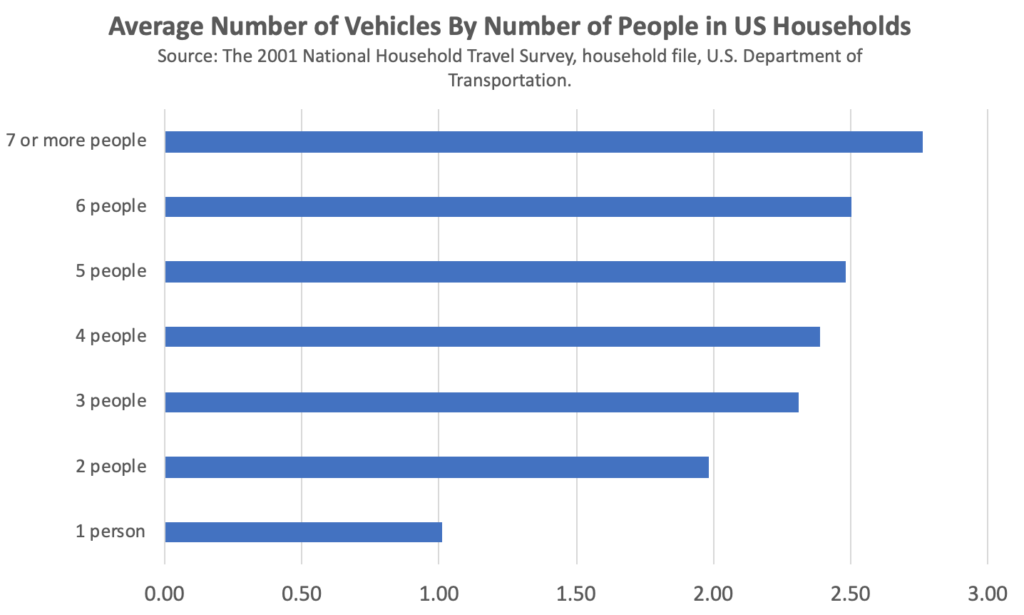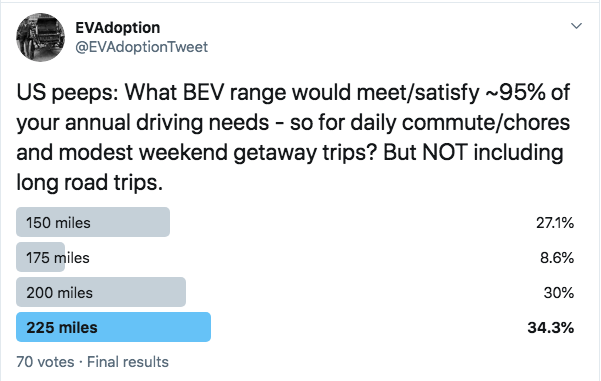There have been several studies and surveys in recent years that peg 300 miles as the minimum amount of range for most Americans to feel comfortable when considering an electric vehicle.
But an August 2019 survey by Autolist, which polled 1,567 current car shoppers about their attitudes towards EVs revealed a nuance to the often touted magic minimum of 300 miles of range:
- Respondents had a realistic expectation of the range on a $35,000 EV; the most common answer was 250-300 miles. (Note: There are currently several EVs in that price range with +/- 250 miles of range.)
- Consumers had far less reasonable assumptions about the range on a $70,000 EV; the most common answer for what range they would accept was ‘More than 500 miles.’
The fundamental issue is that consumers are comparing the ~400 miles of range on their gas-powered vehicle with their expectations of EVs. And on the recent Tesla Q2 earnings call, CEO Elon Musk even declared:
“With regard to passenger vehicles, I think the new normal for range is going to be, just in U.S. EPA terms, approximately 300 miles. So I think people will really come to expect that as some number close to 300 miles as normal.”
Elon Musk, CEO – Tesla
I get it. More range is better and provides greater options and more convenience for drivers. But there are tens of millions of US households that could get by just fine today with a 200-250 mile range EV.
I know from first hand experience that 200-250 miles of range can suffice, especially if you live in temperate climate. My wife and I drove a Model S 60 for three years which had just under 210 miles of range. In those three years there were only 3 trips when that range caused an inconvenience:
- Two round trips to Redlands, CA to take our daughter to college (or pick her up) and return home. In 2018 I wrote a 3-part series for CleanTechnica based on our first of these road trips. The less than 210 miles of range was less than ideal as we had to stop probably 3 extra times on the trip beyond what we normally would have for restroom and leg stretching break and for snacks and meals. (Last year we upgraded to a Model S 100D with 335 miles of range and the trips to/from Redlands these times were a piece of cake.)
- And a trip my wife and daughters took to Carmel, CA which necessitated adding some range in Monterey so they could easily make it home with plenty of range to spare. In that case, they simply planned for it and went to a Tesla Supercharger located at a shopping mall and did some quick shopping and grabbed dinner before continuing on. If they had been driving our current Model S 100 with 335 miles of range that stop would have not been necessary. But as my family loves to shop and eat, that stop for charging, was in fact, not at all inconvenient.
Does Every Household Actually Need 300 Miles of Range?
It makes sense for households that live in cold-weather regions, who take quite a few long trips per year, or only have one vehicle to prefer an EV with at least 300 miles of range. But what about everyone else?
Let’s look at some numbers from a January 2020 AAA survey of electric vehicle owners, 71% of whom had not previously owned an electric car:
- On average, EV owners drive 39 miles per day.
- 78% of EV owners also have a gas-powered vehicle in their household, yet they report doing a majority of their driving (87%) in their electric vehicle.
While 78% of EV owner households also have a second gas-powered vehicle, the number of overall households with two or more cars has increased substantially, to 58% in 2017 from 22% in 1960. So while nearly 6 in 10 households have access to a second vehicle, nearly 8 in 10 early-adopting buyers of EVs have at least one or more other vehicles.
Percentage of Households by Number of Vehicles, 1960-2017
Chart Source: The Geography of Transport Systems
According to Statista, in 2019 there were 128.6 million households in the US. At 58% of households with two or more vehicles, that would amount to just under 75 million households.
At 58% of households with two or more vehicles, that would amount to just under 75 million households.
Source: Statista
Now, some of those second and third vehicles are probably old, small cars or pickups used just for weekend errands and so they might not be ideal for long road trips. Income and where you live also affects how many vehicles are in your household. While I could not find US-wide data on the correlation between income and the number of vehicles in a household, this chart from the Sightline Institute looking at vehicle ownership in Portland shows a very strong correlation between household income and the number of vehicles owned.
And according to a study by Trulia chief economist Issi Romem, cited in Slate, “In dense, transit-rich cities like New York and Boston, vehicle ownership is more closely linked to population density than to income. What kind of neighborhood you live in is likely to align with whether you own a car, or two. In places like Los Angeles and Houston, vehicle ownership is much more closely tied to income. Families who make more money buy more cars.”
And no real surprise, households with 1 person average about 1 vehicle per household, 2-person households nearly 2 vehicles, and 3-7 person households from about 2.3 to about 2.75 vehicles.
Without doing exhaustive research or building a model, let’s just assume that about 25 million or ⅓ of the 75 million households with two or more vehicles:
- Can afford to buy an EV
- Can rely on a second or third car (gas or electric) that could be used for long road trips
- And have convenient access to charging either at home or the workplace.
Lower-Range Electric Vehicles: The Perfect Second Car
For three years we survived just fine with a ~210-mile range EV as our primary car for everyday errands, weekend mid-range trips, and those long road trips I mentioned earlier. Now with a 335 mile range EV, long road-trips are easy, but 99% of the year that extra battery capacity goes completely unused. We are in essence carrying around extra unnecessary weight that makes the car more expensive and less efficient energy wise.
While completely unscientific and a small sample size, I recently conducted a Twitter poll which revealed that at least some consumers would be satisfied with around 200-225 miles of range for their daily, non road-trip needs. In the AAA survey cited early, almost all owners surveyed (95%) report never having run out of a charge while driving. On average, they do three fourths (75%) of their charging at home. And those who likely were originally concerned about insufficient range said they became less or no longer concerned post-purchase (77%).
I believe a huge opportunity for automakers is to target lower-range EVs to households that meet the criteria I outlined above. By focusing on shorter-range EVs (say 175-225 miles of range) as second or third cars, the issues of range and charging infrastructure for road trips and the higher cost of EVs is reduced or eliminated.
These “175-250 mile range” BEVs will often cost $5,000 to $10,000 less than the same model or competitors with around 300 or more miles of range. When you include the Federal EV tax credit of $7,500, state rebates of $500-$5,000, utility rebates of $500, many of these EVs can have an effective cost of $20,000 to $30,000.
BEVs available now or soon that fit in this category, include:
- Nissan LEAF
- Hyundai IONIQ
- Chevrolet Bolt
- Kia Niro
- Hyundai Kona EV
- Kia Soul EV (when it returns to the US)
With Elon Musk and Tesla likely conceding the under $40,000 and 250 miles of range market in the US – at least for another 3-5 years, the question is which OEM(s) can and will target the former Honda Civic and Toyota Corolla market with an attractive, functional and affordable BEV?
There is a clear need for many 300+ mile range electric vehicle models to be available for US consumers who want or need that amount of range, for whatever reason(s). These long-range EVs are also needed from a PR perspective, to convince reluctant or range-concerned buyers that EVs are the equal (or close to it) of ICE vehicles.
But as EV fast charging infrastructure gets built out and 200 miles of range can be added in ~20 minutes, then range and charging concerns become secondary to vehicle cost. In the near term, offering shorter-range EVs to 2 or more car households at a lower price point might be one of the key approaches to significantly increasing EV sales in the US.
 Announcing the acquisition of EVAdoption by Paren →
Announcing the acquisition of EVAdoption by Paren →



5 Responses
Understand your point — it’s why the Volt can be used in EV mode 70%-90% of the time by typical drivers — but for widespread EV adoption, you need long range (equal to gas vehicles — 300 to 500 miles) and short charging times.
Without those 2, many people won’t consider an EV — even if it was priced lower than an ICE. Price parity is far from the only hurdle to US EV adoption. Most people don’t want to calculate that a short-range EV would work 90% of the time when this ICE car works 100% of the time and costs less.
Also agree on the 90% issue … which is why I am a fan of PHEVs – especially those with longer electric ranges – ~35-40+ miles.
I agree. If people are willing to plug in and reduce their gas use by 70% or more, I think the anti-PHEV sentiment is misplaced. Obviously, if they’re never plugged in, that’s a different scenario.
However, even with new PHEVs coming to market, they just aren’t generating a lot of interest among mainstream buyers. I’m not sure what will change that. The Volt was poorly marketed but I’m not seeing amazing advertising for new PHEVs from other automakers. Even GM has acknowledged that to sell the Bolt, they largely targeted Volt owners. Not a recipe to expand the market.
PHEVs can be a good solution for a certain segment of customers. However, PHEVs are not a great solution for people who can’t charge at home (>50% of U.S. population?) and drive regularly (e.g. have a daily commute and no workplace charging, not sure what % of U.S. population that is), because to drive a meaningful percentage of their miles electric would mean charging so frequently.
Your article is quite helpful! I have so many questions, and you have answered many. Thank you! Such a nice and superb article, we have been looking for this information about multi vehicle households in the us a huge opportunity for lower range evs Great post…